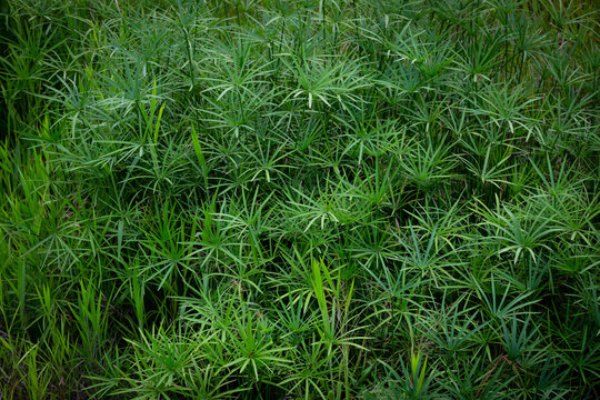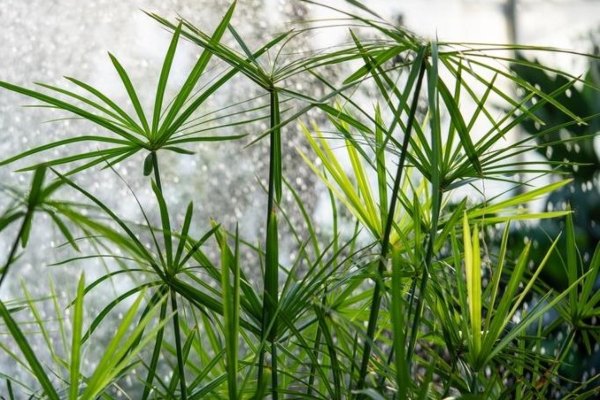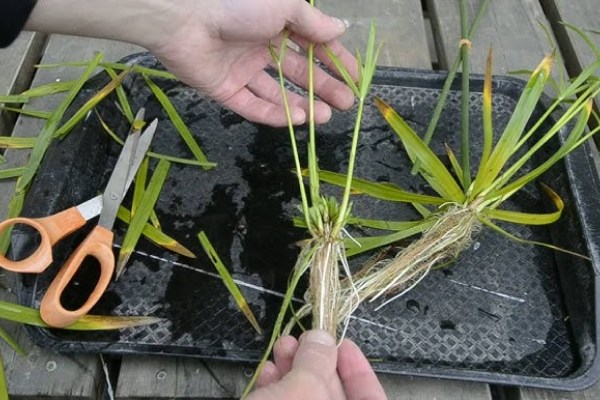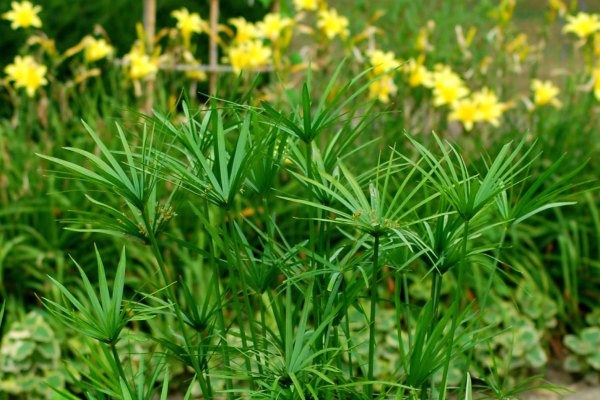Papyrus is a tall, sturdy plant that thrives in aquatic environments. It belongs to the Cyperaceae family and is typically a perennial but can also be grown as an annual in colder regions. Papyrus grows in thick, grass-like clumps made up of green stems with a triangular shape. These stems can reach impressive heights, growing up to 13 to 16 feet tall. Similarly, the stems are firm and have a distinctive triangular form, with a soft, white substance called pith inside. In ancient times, this pit was used to make paper, as well as woven goods like mats and baskets. Besides, papyrus is an edible plant, and people commonly eat its rhizomes either raw or cooked. Here is further information regarding Papyrus including detailed guidance on how to grow and care for the plant properly.
Plant Descriptions
Plant Type: Perennial, Aquatic plant
Scientific Name: Cyperus Papyrus
Family: Cyperaceae
Common Name: Papyrus
Genus: Cyperus
Season: Summer
Native Area: Africa
How to care for your Papyrus Plant
The best time to plant papyrus is in the spring, once the risk of frost has passed. With the right care, such as consistent moisture and proper sunlight, papyrus is relatively easy to maintain and will grow rapidly and vigorously.
Light
Papyrus prefers full sun for optimal growth. However, it can also tolerate partial shade in hot climates as the heat from the sun can dry out the leaves. If you are growing papyrus indoors then artificial light should be provided to help it thrive.
Soil Requirement
Papyrus is an aquatic plant that needs soil to stay consistently wet to boggy. It grows well in swampy areas around ponds, water gardens, and rain gardens where there is plenty of moisture. The plant prefers fertile soil with a pH between 6.0 and 8.0. To keep the soil slightly acidic to alkaline, you can also add compost and organic matter.

Watering
Papyrus requires a lot of moisture to grow well. It can thrive when planted in standing water that is up to 1 foot deep. However, it grows best in shallow water rather than deep water. When planting papyrus, submerge its roots while keeping its top part, known as the crown, above the water.
Temperature and Humidity
Papyrus grows best in warm, hot climates and thrives in areas with high humidity. In North America, it can survive as a hardy perennial that is in USDA hardiness zones 9 and above. However, in areas where winter temperatures fall below 35° F, papyrus is usually treated as an annual plant because it cannot survive frost. To prevent cold, the plant should be moved indoors.
Fertilizer
Papyrus needs to be fertilized to promote healthy stem growth. Give a balanced liquid fertilizer, diluted to half strength once a month during spring. To prevent fertilizer burn, it should be applied while watering the plant.
Pruning
The plant doesn’t need pruning unless for aesthetic purposes. Some leaves may turn brown with a lack of water so, it is important to remove them immediately. In regions where papyrus grows perennially, it is best to trim the leaves down to the ground in the fall or early spring. However, if the plant only lasts for one season, you should remove it thoroughly at the end of that season.
Why is my Papyrus plant turning yellow?
Papyrus is primarily grown for its attractive foliage. If its leaves start to turn yellow then it loses its charm and aesthetic appeal. Here are some common reasons why your papyrus might be turning yellow:
Underwatering
This yellowing of the leaves typically occurs when the papyrus plant doesn’t receive sufficient water, as it thrives best in consistently moist soil. If the soil becomes too dry, the leaves may start to turn yellow. To prevent this, it is important to water the plant regularly, particularly during dry or hot weather. You can also use containers that help to maintain the proper moisture level in the soil, ensuring the plant stays healthy and vibrant.
Overwatering
Papyrus plants need the soil to stay moist, but giving them too much water can cause their roots to rot. Therefore, it is crucial to monitor how wet the soil is and adjust how often you water based on the weather and what the plant needs to stay healthy. To avoid overwatering, using a soil moisture meter can be an effective way to determine when the plant needs water.

Pests and Diseases
Papyrus plants are generally resistant to pests, but they can sometimes get fungal diseases. If you notice spots or discoloration appearing on the leaves and stems, it is often a sign of rust fungus affecting the plant. To help the plant stay healthy, ensure it has good airflow and keep the garden clean. You might also consider using organic or synthetic fungicides to treat the infection and protect the plant.
Season Changes
Season changes can significantly impact papyrus plants and cause their leaves to turn yellow. It grows best in warm climates and has difficulty with cold temperatures. During fall and winter, when it gets colder, you need to move the plant indoors. Also, increasing the humidity around the plant during winter can help prevent the leaves from turning yellow.
Inadequate Light Exposure
Papyrus need a bright, indirect light to thrive. If they don’t get enough light, their leaves may start to yellow and lose their vibrant green color. To prevent this, you need to place the plant in a location where it receives ample light. However, it can also tolerate partial shade in extremely hot climates
How to Propagate Papyrus Plants?
Papyrus can be easily propagated by dividing the rhizomes from the mother plant. Here is a detailed step-by-step guide to help you divide and plant papyrus:
Step 1: Start trimming the tall stalks and removing brown or dead leaves. Next, carefully dig up the whole plant. Be gentle during this process to avoid damaging the roots.
Step 2: Once the plant is out of the ground cut off older or unhealthy rhizomes. Then gently pull apart the roots with your hands to separate the plant into smaller sections.
Step 3: Ensure each section has some healthy rhizomes. Now, replant each divided section at the same depth as the original plant.
Step 4: Choose a wet area for replanting, and water each section thoroughly to encourage strong root development and healthy growth.
Growing Papyrus from seeds
If you are growing papyrus from seeds, first spread the seeds evenly on the surface of the soil. Next cover the seeds with a thin layer of soil to ensure they are properly nestled. Well, the papyrus seeds will usually take about one month to germinate. When planting these seeds, it is important to avoid overwatering. You do not need to water the seeds every day, however, aim to keep the soil consistently damp without making it too soggy.

Also read, Growing and Caring Tips for Pilea Involucrata (Friendship Plant)
Frequently Asked Questions
1. What is Papyrus?
Papyrus is a tall, aquatic plant from the Cyperaceae family. It is known for its green, triangular stems which grow in thick, grass-like clumps.
2. Can Papyrus thrive inside your home?
Yes, you can grow papyrus indoors as long as you give it adequate sunlight and consistent moisture.
3. How fast does Papyrus grow?
Papyrus is known for its rapid growth and can reach up to the height of 13 to 16 in a single growing season if it gets enough sunlight and moisture.
4. How often should I fertilize Papyrus?
Papyrus should be fertilized once a month during the growing season. Apply a balanced liquid fertilizer diluted to half-strength.
5. How long does it take for Papyrus seeds to germinate?
Papyrus seeds usually take about a month to germinate. However, make sure the soil is kept consistently damp but not overly wet to promote healthy seedling development.
